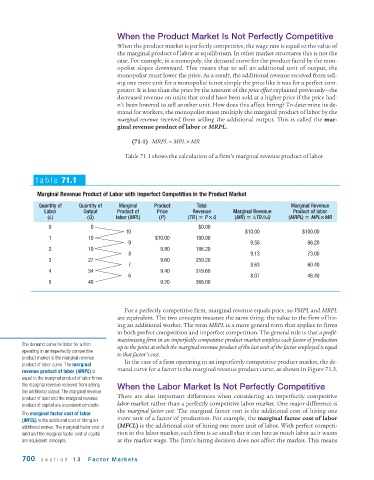Page 742 - Krugmans Economics for AP Text Book_Neat
P. 742
When the Product Market Is Not Perfectly Competitive
When the product market is perfectly competitive, the wage rate is equal to the value of
the marginal product of labor at equilibrium. In other market structures this is not the
case. For example, in a monopoly, the demand curve for the product faced by the mon -
opolist slopes downward. This means that to sell an additional unit of output, the
monopolist must lower the price. As a result, the additional revenue received from sell-
ing one more unit for a monopolist is not simply the price like it was for a perfect com-
petitor. It is less than the price by the amount of the price effect explained previously—the
decreased revenue on units that could have been sold at a higher price if the price had-
n’t been lowered to sell another unit. How does this affect hiring? To determine its de-
mand for workers, the monopolist must multiply the marginal product of labor by the
marginal revenue received from selling the additional output. This is called the mar-
ginal revenue product of labor or MRPL.
(71-1) MRPL = MPL × MR
Table 71.1 shows the calculation of a firm’s marginal revenue product of labor.
table 71.1
Marginal Revenue Product of Labor with Imperfect Competition in the Product Market
Quantity of Quantity of Marginal Product Total Marginal Revenue
Labor Output Product of Price Revenue Marginal Revenue Product of labor
(L) (Q) labor (MPL) (P ) (TR ) P Q (MR) ΔTR/ΔQ (MRPL) MPL MR
0 0 $0.00
10 $10.00 $100.00
1 10 $10.00 100.00
9 9.58 86.20
2 19 9.80 186.20
8 9.13 73.00
3 27 9.60 259.20
7 8.63 60.40
4 34 9.40 319.60
6 8.07 48.40
5 40 9.20 368.00
For a perfectly competitive firm, marginal revenue equals price, so VMPL and MRPL
are equivalent. The two concepts measure the same thing: the value to the firm of hir-
ing an additional worker. The term MRPL is a more general term that applies to firms
in both perfect competition and imperfect competition. The general rule is that a profit-
maximizing firm in an imperfectly competitive product market employs each factor of production
The demand curve for labor for a firm up to the point at which the marginal revenue product of the last unit of the factor employed is equal
operating in an imperfectly competitive to that factor’s cost.
product market is the marginal revenue
product of labor curve. The marginal In the case of a firm operating in an imperfectly competitive product market, the de-
revenue product of labor (MRPL) is mand curve for a factor is the marginal revenue product curve, as shown in Figure 71.3.
equal to the marginal product of labor times
the marginal revenue received from selling When the Labor Market Is Not Perfectly Competitive
the additional output. The marginal revenue
product of land and the marginal revenue There are also important differences when considering an imperfectly competitive
product of capital are equivalent concepts. labor market rather than a perfectly competitive labor market. One major difference is
the marginal factor cost. The marginal factor cost is the additional cost of hiring one
The marginal factor cost of labor
(MFCL) is the additional cost of hiring an more unit of a factor of production. For example, the marginal factor cost of labor
additional worker. The marginal factor cost of (MFCL) is the additional cost of hiring one more unit of labor. With perfect competi-
land and the marginal factor cost of capital tion in the labor market, each firm is so small that it can hire as much labor as it wants
are equivalent concepts. at the market wage. The firm’s hiring decision does not affect the market. This means
700 section 13 Factor Markets

